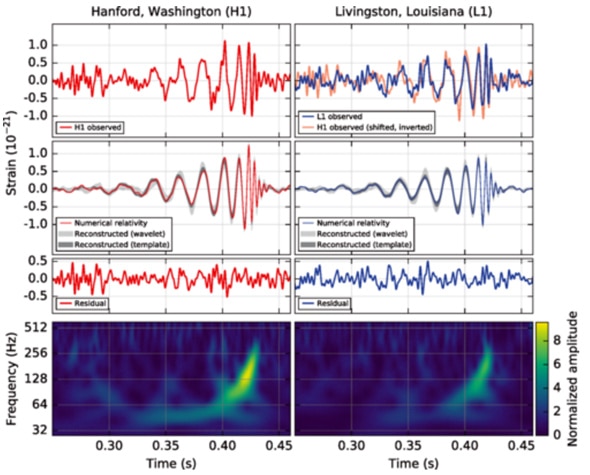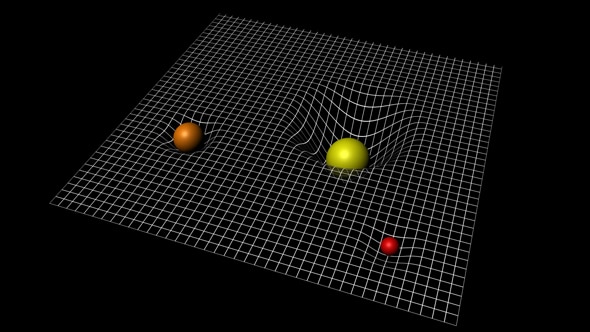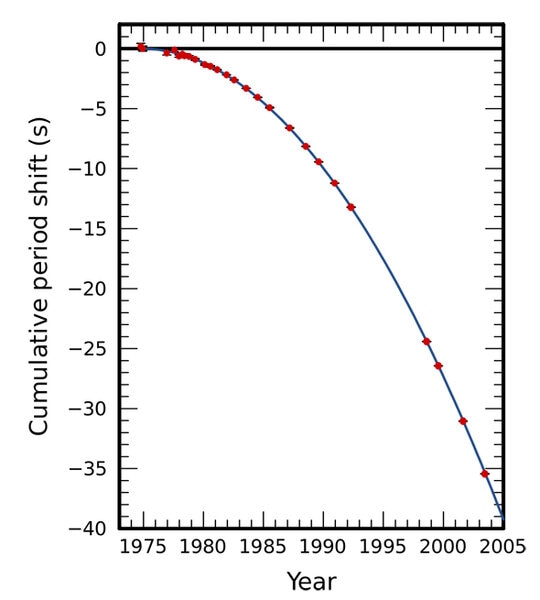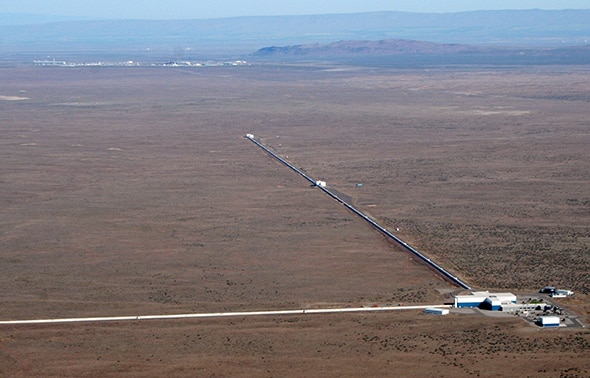Create a free profile to get unlimited access to exclusive videos, sweepstakes, and more!
LIGO Sees First Ever Gravitational Waves as Two Black Holes Eat Each Other
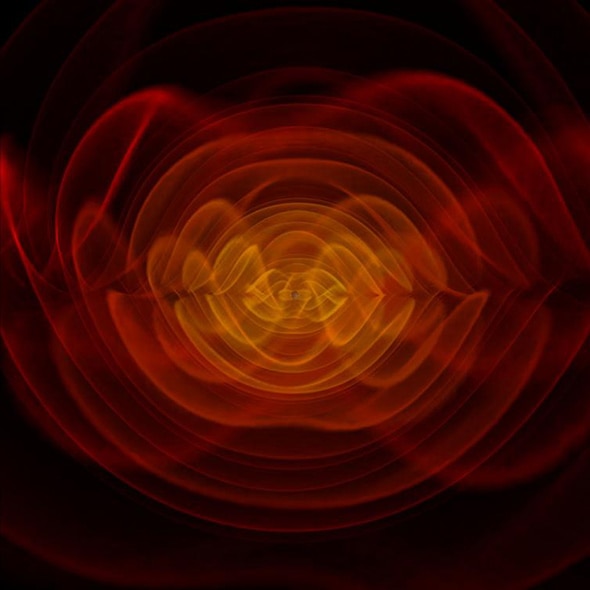
Better start shining up some new Nobel Prize medals: Scientists have reported that, for the very first time in history, they have detected gravitational waves.
And oh my yes, this is a very big deal. It will open up an entirely new field of astronomy, a new way to observe the Universe. Seriously.
Gravitational waves (not to be confused with gravity waves, which are a totally different thing) are ripples in the fabric of spacetime, caused when a massive object is accelerated. By the time they get here from distant astronomical objects, the waves have incredibly low energy and are phenomenally difficult to detect, which is why it’s taken a century to discover them since they were first predicted by Einstein’s Theory of General Relativity. Essentially every other prediction of GR has been found to be correct, but the existence of gravitational waves has been maddeningly difficult to prove directly.
Until now. And what caused the gravitational waves they detected at the Laser Interferometer Gravitational-Wave Observatory is as amazing and mind-blowing as the waves themselves: They caught the death spiral and aftermath of two huge black holes 1.3 billion light-years from Earth, merging together in a titanic and catastrophically violent event.
Mind you, we’ve had some good evidence such binary black holes existed before this, but this new result pretty much proves they exist and that, over time, they eventually collide and merge. That’s huge.
The black holes had masses of 36 and 29 times the mass of the Sun before they merged. After they merged they created a single black hole with a mass of 62 times that of the Sun. You may notice those masses don’t add up right; there’s 3 solar masses missing. That mass didn’t just disappear! It was converted into energy: the energy of the gravitational waves themselves. And the amount of energy is staggering: This single event released as much energy as the Sun does in 15 trillion years.
I know. There is nothing about this story that isn’t incredibly cool.
So, to understand all this better you’ll need a wee bit of background. This is all very mind-bendy stuff, but I promise it’s worth it.
What Is a Gravitational Wave, Anyway?
One of the outcomes of Einstein’s General Relativity theory is that space and time are two facets of the same thing, which we call spacetime. There are lots of analogies for it, but you can think of it as the fabric of space, a four-dimensional tapestry (three of space and one of time) in which we are all embedded. Remember, it’s not literally like this; we’re using an analogy. But it’ll help you picture it.
We think of gravity as a force, pulling us toward an object. But Einstein revisualized it, seeing it as an outcome of the warping of spacetime. A massive object distorts the shape of space, and another object moving through that warped space gets accelerated. We see that as gravity. In other words, matter tells space how to bend, and space tells matter how to move.
Another outcome of the mathematics of GR is that if a massive object is accelerated, it will cause ripples, waves, to move away from itself as it moves. These are actually ripples in the fabric of spacetime itself! Spacetime expands and contracts in complicated ways as a wave passes, a bit like how ripples will move out from a rock dropped into a pond, distorting the surface of the water.
There are lots of ways to generate gravitational waves. The more massive and dense an object is, and the harder it accelerates, the sharper and more energetic the waves are. The Earth moves around the Sun once per year, accelerated by the Sun’s gravity. But the motion is too slow and the Earth’s mass too low to ever hope to detect the mushy waves emitted.
But if you have two much more massive objects—like, say, neutron stars, the über-dense cores of stars that have previously exploded—they do generate waves that we can see.
In fact, we have! Kinda. In 1974, a binary neutron star system was discovered by astronomers Joseph Taylor and Russell Hulse. These two massive objects orbited each other very rapidly, once every eight hours or so. As they do, they emit a tiny bit of energy in the form of gravitational waves. That energy comes from the orbital energy of the stars themselves, so as they emit gravitational waves, they lose orbital energy. The orbit shrinks, and the time it takes the two stars to revolve around each other drops. Over time, that “orbital decay” can be very precisely measured … and it was seen! Not only that, it matched the prediction of GR perfectly.
Taylor and Hulse won the Nobel Prize for this. And they only detected gravitational waves indirectly. They saw how the loss of energy by emitting the waves affected the stars’ orbits. But they didn’t detect the waves themselves.
So How Did LIGO Do It?
Gravitational waves come in many shapes and forms, but what they all do is infinitesimally distort the shape of space. But how do you measure that? It’s not like you can hold a ruler up between two objects and measure how their distance apart changes when a wave passes through …
… right? Oh, wait. It turns out you can.
Enter LIGO: The Laser Interferometer Gravitational-Wave Observatory. LIGO is actually two facilities, one located in Washington state and the other in Louisiana (jointly operated by Caltech and MIT). Neither is what you might think of as an astronomical observatory: They each consist of very long pipes arranged in an L-shape. At the far end of each 4-kilometer-long pipe is a mirror.
A very powerful laser sits near the vertex of the L, where the pipes meet. It sends out a pulse of light into a special mirror that splits the beam, sending half of it down one pipe, and the other half down the other pipe. Each mirror reflects is beam back down the pipe, and then they’re recombined inside a detector.
Here’s a video (credit: NSF) describing how this works:
Let me add what’ll seem like a bit of a non sequitur to help make this clear: Have you ever sat in a tub of water and sloshed your body back and forth? If you time it just right, you can amplify the wave of water coming back at you, making it splash higher. You can also time it just right so that you move in a way to negate the wave coming at you, too.
The motion of your body sets up the first wave. When you move again, you make a second wave. It the crest of the first wave hits the crest of the second wave, they amplify each other. If the trough of the second wave hits the crest of the first one, they negate each other.
This is called interference. Where the waves amplify it’s constructive interference, and where they negate each other its destructive interference.
Light is a wave. If the laser and the two mirrors in LIGO are set up just right, then the two beams will interfere with each other when they reach the detector. Interference patterns, called fringes, can be seen when you do that, and the exact pattern seen depends, in part on the exact distance between the mirrors. If one mirror moves a tiny bit relative to the other, then the fringe pattern changes.
See where this is going? If a gravitational wave passes through LIGO, one mirror will move a teeny tiny amount relative to the other, and that will create a change in the fringe pattern. Fringes are sensitive to extremely small changes in mirror position, so this is a great way to look for gravitational waves.
How sensitive? A typical gravitational wave will move the mirrors by about 0.0001 times the size of an atomic nucleus! So yeah, they’re sensitive.
LIGO has two such setups located thousands of kilometers apart to help distinguish real astronomical sources from things like earthquakes, trucks driving by, and so on. LIGO first went into operation in 2002. Over nearly a decade it looked but found no gravitational waves. In 2010 it shut down for a significant upgrade, making it far more sensitive. This new configuration started observing in September 2015.
Apparently, all this time they were right on the threshold of detection. Once the more sensitive rig was employed, it didn’t take long before they hit paydirt: This signal was detected on Sep. 14!
What Did They See?
Now we’re ready to put all this together.
Imagine two black holes in a very tight orbit around each other. Both are massive, and whipping around each other at a large fraction of the speed of light. They’ll be pouring out gravitational waves, ripples in spacetime expanding away at the speed of light. It’s possible LIGO could detect something like that, but there’s more to this.
As the black holes whirl madly and emit gravitational waves, they lose orbital energy. Like the neutron stars that got Taylor and Hulse their Nobel, the orbit of the two black holes shrinks. They revolve around each other ever faster.
This change in their orbital rate affects the waves they emit. The frequency of the waves (how many are emitted per second) depends on how rapidly the two objects orbit each other. As the orbit of the black holes shrinks, they revolve around each other faster, and the frequency of the gravitational waves goes up. But, since the black holes are moving more rapidly, they emit even more waves, so they lose energy faster, so they emit even more waves.
This is a runaway effect. The black holes get closer and closer together, whirl around each other faster, emit more and stronger gravitational waves with a higher frequency … until the black holes eat each other! They merge, becoming one (slightly larger) black hole.
Here’s an animation showing this phenomenon (using white dwarfs instead of black holes):
What LIGO sees when this happens is the signature of the gravitational waves, with the frequency going up all the time. Sound is also a wave, and the frequency of sound waves is what we interpret as its pitch. A higher frequency sound has a higher pitch; it’s a higher note, if you prefer.
As the black holes get close to merging, their frequency rockets up. In the sound analogy, it’s like they’re singing a note, and as they get closer the note gets stronger and stronger and higher and higher. At the end, the increase in pitch is so rapid it goes way up extremely quickly: This is a chirp.
Literally, a chirp is a sound where the frequency increases rapidly (listen to one here). So the signature of two black holes (or neutrons stars, or even white dwarfs) inspiraling and merging is a chirp in the gravitational waves. If you catch that, you’ve witnessed the black holes at The Moment Of Truth, when two become one.
And one last bit that boosts confidence: The signal from the merging black holes was detected in the Washington state detector first, then in the Louisiana detector 7 milliseconds later. That delay was due to the waves moving at the speed of light across space!
This merger is simply astonishing. It’s one of the most catastrophic events in the Universe, and until just last year we were essentially blind to it.
LIGO has opened our eyes.
What’s Next?
With this detection by LIGO, a new era in astronomy begins. In many cases, the gravitational waves are emitted from objects we can’t see directly, like black holes merging, or binary neutron stars. Sometimes, though, these objects do emit visible light. A supernova—an exploding star—can emit gravitational waves. Even more dramatically, when two neutron stars merge and form a black hole, they release not just gravitational waves, but also a huge flash of energy in the form of gamma rays and even visible light. These gamma-ray bursts occur in the Universe every day, and we see them all the time. If we can also detect the emitted gravitational waves from them, it will help astronomers understand these bizarre and incredibly violent phenomena.
Even better, we’re not starting fresh. Last year, the European Space Agency launched LISA Pathfinder into space. LISA stands for Laser Interferometer Space Antenna, and is basically a super-LIGO in space. LISA Pathfinder is a benchmark mission to test the very sophisticated technology involved. If it works, then a full-up LISA may be launched in the coming years, which will consist of three separate detectors separated in space by millions of kilometers. Its sensitivity will be far, far higher than LIGO’s, and will rip the field of gravitational wave astronomy wide open.
Whenever we find a new window into the Universe—radio waves, gamma rays, even the invention of the telescope itself—immense wonders have been our reward. In the vast majority of cases we had no clue what was waiting for us once we peered outwards in a new way. Stars numbered beyond imagining, galaxies packed together clear across the cosmos, planets, nebulae, and even an eventual understanding of how the Universe came to be, how it changes, and how it will evolve in the future.
The treasures, the beauty, the knowledge, have fundamentally changed how we humans see ourselves and our place in the Universe. And here we stand, our hand on another window, ready to throw it open.
What will we see when we look through?
Further Reading
- Markus Pössel at Universe Today has a great write-up on the details of how LIGO works.
- Of course the LIGO page is chock full o’ info and has a nice tutorial on gravitational waves.
- Seth Fletcher at Scientific American has a good essay on what this all means.
- You should read Ethan Siegel’s piece at Forbes, too.
